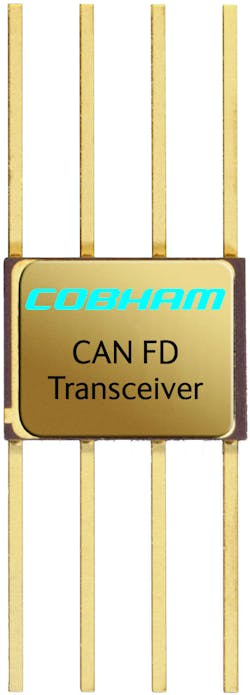Cobham debuts RadTolerant controller area network flexible datarate transceiver
“Cobham’s RadTolerant CAN FD transceivers allow for the implementation of robust low-level networks within spacecraft, saving weight and power,” Product Marketing Manager Elaine Gonsalves explains. Cobham engineers designed the UTCAN333X series to meet industry’s demand and are now working with designers on future flight applications using prototypes.
“This series of CAN transceivers were developed in accordance with ISO 11898-2 and 11898-5 standards, the latter in support of CAN FD,” Gonsalves adds. “The UT64CAN333x series are capable of baud rates between 10 kbps to 8 Mbps (fastest in the market) and include a slope-control mode to control the slew rate of the transmissions for baud rates of up to 500kbps. A standby mode disables the transmitter circuit to conserve power while monitoring the bus for activity. The UT64CAN333x series of transceivers can support up to 120 nodes.”
The three transceiver options are:
- UT64CAN3330, providing a low-power sleep mode of operation;
- UT64CAN3331, supporting a bus isolated diagnostic loopback; and
- UT64CAN3332, with the ability to monitor bus traffic enabling the local controller to change its baud rate to match the operations of the bus.
The RadTolerant CAN transceivers are the only on the market supporting CAN FD (up to 8 Mbps) and have superior radiation performance of 100 krad(Si) total dose with latch up of LET < 100 Mev-cm2/mg, according to company officials.
The UT64CAN333x series is packaged in an 8-lead ceramic flatpack. Prototypes are available now from Cobham Semiconductor Solutions in Colorado Springs, Colo. Production parts will be offered with SMD number 5962-15232. QML-Q/Q+ production are expected by year end and QML-V production is expected in mid-2016.
Cobham Semiconductor Solutions is a global supplier of Standard HiRel ICs including memory, µprocessor, interconnect, and power and ASICs for space, commercial, medical, and industrial markets, along with electronic manufacturing services (circuit card assembly, radiation testing, component upscreening, and packaging).
Intelligent Aerospace exclusive: an interview with Elaine Gonsalves, Product Marketing Manager, Cobham Semiconductor Solutions
Aerospace technology for system design, development, prototyping, test, and deployment The RadTolerant CAN series is a new product area for Cobham – expanding its interface solutions, affirms Cobham Semiconductor Solutions Product Marketing Manager Elaine Gonsalves. “CAN has been used primarily in the automotive industry for years. The space market, particularly in Europe, started looking at CAN more closely, and adopting it in space programs for autonomous functions. They have flown commercial equivalents that had short life and no stringent radiation requirements; whereas ours are designed for space, to be radiation-tolerant.
“We’re seeing more interest in this bus architecture in applications worldwide because it is size, weight, and power (SWaP) are key for space,” Gonsalves says. “Hundreds can be on a single bus, enabling centralized intelligence and autonomous functions.
“CAN is a different bus architecture; more satellites are looking at going to CAN. Not for modernizing currently fielded platforms, but for new designs – for satellite architectures that are using that CAN bus topology for their mission,” Gonsalves adds.
Key differentiators of the Cobham series of the products include radiation tolerance and the fastest speed, up to 8 megabits per second (Mbps) – the fastest on the market, according to Gonsalves. Also, she describes, “three different options are offered – each in a small package.
“Certainly there are exciting missions looking for CAN; constellations of multiple (hundreds of) low-cost, small satellites are looking at CAN as the bus architecture,” Gonsalves says. “There is and will be a need for these CAN transceivers for these types of missions.
“We’ve been shipping to strategic customers since May,” Gonsalves explains. “More than a dozen customers have initial parts in their hands for evaluation.” Cobham CAN transceivers are garnering interest at conferences and trade shows, and the company is shipping prototypes internationally and domestically.
You might also like:
Subscribe today to receive all the latest aerospace technology and engineering news, delivered directly to your e-mail inbox twice a week (Tuesdays and Thursdays). Sign upfor your free subscription to the Intelligent Inbox e-newsletter at http://www.intelligent-aerospace.com/subscribe.html.
Connect with Intelligent Aerospace on social media: Twitter (@IntelligentAero), LinkedIn,Google+, and Instagram.
